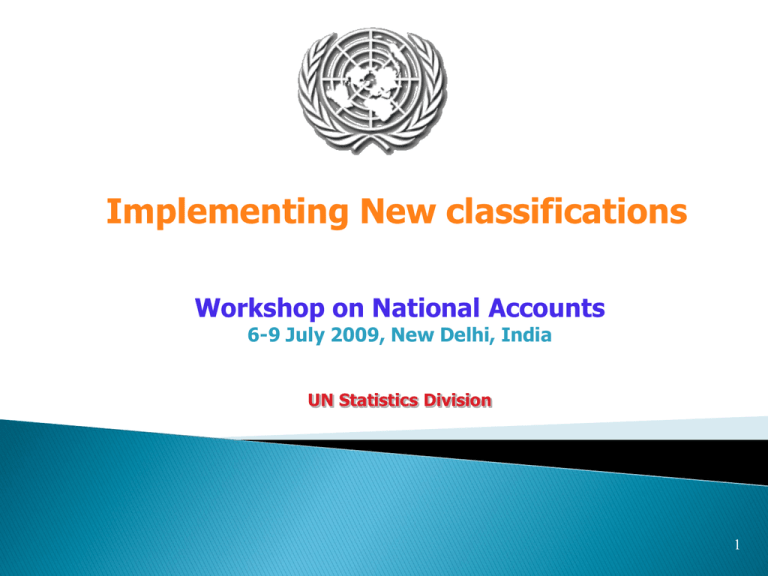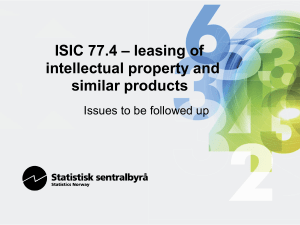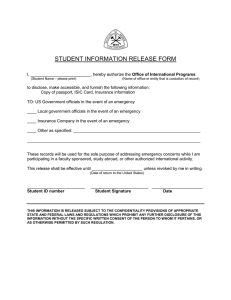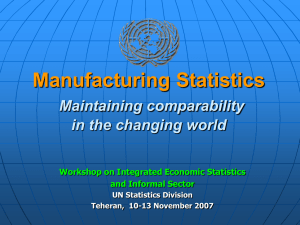Implementing New classifications Workshop on National Accounts UN Statistics Division
advertisement

Implementing New classifications Workshop on National Accounts 6-9 July 2009, New Delhi, India UN Statistics Division 1 Presentation Plan Introduction Overview of ISIC changes Implementation process - Steps Structuring national classifications Adaptation of business register Points for discussion Introduction Since its creation in 1948, ISIC had two goals: Provide a tool for international comparison Provide guidance to countries for a national activity classification structure ISIC periodically updated to keep it relevant with economic developments. Side effect: Increasing need for detailed data has lead to more detailed versions of ISIC Structuring national classifications Creation of a new national version of national classification (NSIC) according to ISIC Rev.4 for national use Recoding Business Register Switchover in the Business Register to new NSIC Statistics update process Co-ordinate simultaneous switchover in statistics to new NSIC and the control of the quality of time series Increase in top-level categories Increase in overall detail New concepts (information, professional services, support services) New application rules (vertical integration, top-down method, outsourcing) ISIC Rev.3 ISIC Rev.4 Sections 17 21 Divisions 60 88 Groups 159 238 Classes 292 419 6 Despite many changes, a lot of areas in ISIC have not changed Manufacturing as a “historical” area remains relatively stable Most application rules remain intact ISIC Rev.4 ISIC Rev.3.1 A Agriculture, forestry and fishing B Mining and quarrying A Agriculture, hunting and forestry C Manufacturing B Fishing D Electricity, gas, steam and air conditioning supply C Mining and quarrying E Water supply; sewerage, waste management and …… D Manufacturing F Construction E Electricity, gas and water supply G Wholesale and retail trade; Repair of motor vehicles … F Construction H Transportation and storage G Wholesale and retail trade; … I Accommodation and food service activities Hotels and restaurants J Information and communication H K Financial and insurance activities I Transport, storage and communications L Real estate activities J Financial intermediation M Professional, scientific and technical activities K Real estate, renting and business … N Administrative and support service activities L Public administration … O Public admn and defence; compulsory social sec M Education P Education N Health and social work Q Human health and social work activities O Other community, social, personal … R Arts, entertainment and recreation P Activities of private households S Other service activities Q Extraterritorial organizations and bodies T Activities of households as employers… U Activities of extraterritorial organizations and bodies 58 - Publishing activities 59 - Motion picture, video, television programme production, sound recording and music publishing activities 60 – Programming and broadcasting activities 61 - Telecommunications 62 – Computer programming, consultancy and related activities 63 - Information service activities 221 ”Publishing” ( in “Manufacturing”) 72 “Computer and related activities” except 725 (in “Real estate, renting and business activities”) 642 “Telecommunications” (in “Transport, storage and communications”) 92 “Recreational, cultural and sporting activities” (9211, 9212, 9213, 9220, 9231 in “Other community, social and personal service activities”) Major tasks and challenges: Defining a new classification and associated tools Reclassification of all units on the business register according to the revised classification Maintaining two classifications for an interim period Sampling and weighting under the new classification Major tasks and challenges: Simultaneous estimation and results assessment under both new and old classification Construction of industry weights Construction of back series in terms of the revised classification Handling of the national accounts move to the revised classification How can national classifications be structured? 1. Using ISIC as a starting point 2. Based on historical national versions 3. Starting completely from scratch Link link between ISIC and NACEtruncation” Combining ofthrough ISIC categories ISIC “numerical Countries that use ISIC as a basis for their national ISIC Rev.4 Nationaldegrees: Classification classification, can do this to varying ISIC Rev.4 NACE Rev.2 ISIC Rev.4 National Classification 2311 Manufacture of flat glass 1. Adopt ISIC “as-is”2311 Manufacture Manufactureof offlat flatglass glass 2310 Manufacture of glass and glass 23101 2319 Manufacture and processing of other glass 2312 Shaping and processing flatglass glass to 23102 processing ofofflat 2. Use the complete ISICShaping and and add subdivisions products 2310 Manufacture of of glass glass and and 2313 Manufacture Manufactureof ofhollow hollowglass glass 2391 Manufacture of refractory glass products products reflect nationally23103 important industries (but maintain 2314 Manufacture of glass fibres 23104 Manufacture of glass fibres products 2390 Manufacture of refractory products and clay the ISIC coding structure) –materials can be “numerically 2319 Manufacture andprocessing processing otherglass, glass, 23109 building Manufacture and ofofother including technicalglassware glassware including technical truncated” back to ISIC [Example] 2392 Manufacture of clay building of refractory refractory 2320 Manufacture Manufactureof ofrefractory refractoryproducts products 2391 Manufacture of 23910 materials 3. products As above, but with changes of the coding structure 2331 Manufacture ofceramic ceramictiles tilesand andflags flags table Manufacture of (example: NACE)23921 – requires correspondence of clay clayis building 2392 Manufacture of building International comparability reduced 2332 Manufacture Manufactureof ofbricks, bricks,tiles tilesand andconstruction construction 23922 [Example] materials products, in inbaked bakedclay clay products, Correspondence table is required. 4. Elevating lower level ISIC categories to higher national levels, (e.g. combine ISIC categories at 2comparability is is maintained. maintained. International comparability or 3-digit level) [Example] However, correspondence table is required. No additional tools are required. The first three methods maintain full comparability with ISIC at all levels Option 4 limits internationally comparability to a higher aggregation level only Is use of the same coding as ISIC 4 a requirement? - No, but it makes comparisons easier. Using non-ISIC based classifications always creates difficulties for international comparison Correspondence tables are necessary May limit data conversion due to splits Efforts are encouraged to line the historical versions up to ISIC At detailed level (without considering aggregation structures) or By lining up individual sections The United Nations Statistical Commission recommends that detailed categories of a national classification can be rearranged and aggregated so that they correspond with the 2-digit level of ISIC without loss of data. However, most statistics and users will require more Countries might want to add detail for industries of particular importance to the national economy. Countries might want to remove detail for reasons involving size and relevance, confidentiality or homogeneity Classification for collection may be more detailed than for distribution of data Using more detail for collection allows for future adjustments if individual industries are growing Level of detail for publishing depends on type of statistics anyway No fixed guidelines exist for the proper choice of detail ISIC Possible approaches Based on variables like: • # of statistical units • # of employees • value added With chosen variable, compute ratio R between what is found within a category and average among “siblings”: • R < 0.5 => delete • R [0.5, 1.5] => keep • R > 1.5 => split Drawbacks: •Hard to define levels/weights • Level of detail influence outcome • Ignore dynamic aspects Homogeneity based Based on: Homogeneity ratios (as described in ISIC Rev. 3) Compress or expand classification based the value of these ratios Drawbacks: • Not enough usable data • No definitive and mutually exclusive definition of activities by products Based on: • Input from data users • Special concerns (confidentiality, extra burden, growing industries) • New subclasses only created if user demand • Data users must justify their needs for splits, and estimate number of affected units and turnovers • Take confidentiality and extra burden into account in advance • No strict thresholds Drawbacks: • Challenging and intense discussions, not all user needs can be met ISIC structure and definition are based on few criteria (input, process, output, use of outputs) Should other criteria be added for national purposes, such as private vs. public entity, manufacturing by hand (crafts) vs. manufacturing by machines? What are the applications? Generally, avoid unnecessary addition of detail When following the ISIC structure and coding system, don’t renumber codes if you want to skip a code number Regardless of legality, size or other concerns, it is still within conceptual scope, and must be accounted for in the SNA. Renumbering makes the ISIC link less intuitive Rules for good housekeeping If a category at level n is not further subdivided, the code at level n+1 should be the same code with a “0” appended Use digit “9” for residual categories Expert Group Expert Group discussed a proposal for the implementation of ISIC and CPC at its meeting in April 2007 Main recommendations relate to: Timetable Documentation and tools Regional workshops Technical cooperation EG recommended two milestones: Countries should adapt their national classification to ISIC Rev.4 by 2009 To meet population census target of 2010 International data reporting in ISIC Rev.4 format should begin in 2012 No specific dates have been recommended for completion of: Adaptation of business register Sample designs and weights for surveys Backcasting Reasons: ◦ The timing and organization of surveys varies by country ◦ Scope (length) of backcasting differs by country UNSD will develop: A Companion Guide to ISIC and CPC that helps to understand: the concepts and structure of the classifications Application of the classification Correspondence tables ISIC and CPC indexes UNSD will also set up an open discussion forum and expand the classifications website into a larger knowledge platform Major tasks and challenges: Defining a new classification and associated tools Reclassification of all units on the business register according to the revised classification Maintaining two classifications for an interim period Sampling and weighting under the new classification Simultaneous estimation and results assessment under both new and old classification Construction of industry weights for short term statistics Construction of back series in terms of the revised classification Handling of the national accounts move to the revised classification Sources: Direct (straight) recoding (1:1 link) Problems for 1-n and m - n links Internal sources External sources Information from profiling of large and complex enterprises Existing business activity descriptions can some times be used to allocate split codes between old and new classifications NSO may depend on external registers (tax registration, social security, chambers of commerce etc.) If admin sources convert to new classification at exactly the same time as the statistical BR of NSO – then admn source is helpful to determine the correct new code for the business Has the process for implementing new classifications been set up by the South Asian countries? If Yes – Status No – Plan for implementation Thank You



